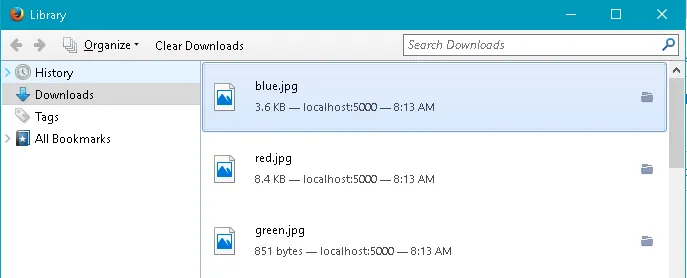如何使用ASP.NET Core创建一个多部分HTTP响应
我编写了一个更加通用的MultipartResult类,它只是继承自ActionResult:
使用示例
[Route("[controller]")]
public class MultipartController : Controller
{
private readonly IHostingEnvironment hostingEnvironment;
public MultipartController(IHostingEnvironment hostingEnvironment)
{
this.hostingEnvironment = hostingEnvironment;
}
[HttpGet("")]
public IActionResult Get()
{
return new MultipartResult()
{
new MultipartContent()
{
ContentType = "text/plain",
FileName = "File.txt",
Stream = this.OpenFile("File.txt")
},
new MultipartContent()
{
ContentType = "application/json",
FileName = "File.json",
Stream = this.OpenFile("File.json")
}
};
}
private Stream OpenFile(string relativePath)
{
return System.IO.File.Open(
Path.Combine(this.hostingEnvironment.WebRootPath, relativePath),
FileMode.Open,
FileAccess.Read);
}
}
实现
public class MultipartContent
{
public string ContentType { get; set; }
public string FileName { get; set; }
public Stream Stream { get; set; }
}
public class MultipartResult : Collection<MultipartContent>, IActionResult
{
private readonly System.Net.Http.MultipartContent content;
public MultipartResult(string subtype = "byteranges", string boundary = null)
{
if (boundary == null)
{
this.content = new System.Net.Http.MultipartContent(subtype);
}
else
{
this.content = new System.Net.Http.MultipartContent(subtype, boundary);
}
}
public async Task ExecuteResultAsync(ActionContext context)
{
foreach (var item in this)
{
if (item.Stream != null)
{
var content = new StreamContent(item.Stream);
if (item.ContentType != null)
{
content.Headers.ContentType = new System.Net.Http.Headers.MediaTypeHeaderValue(item.ContentType);
}
if (item.FileName != null)
{
var contentDisposition = new ContentDispositionHeaderValue("attachment");
contentDisposition.SetHttpFileName(item.FileName);
content.Headers.ContentDisposition = new System.Net.Http.Headers.ContentDispositionHeaderValue("attachment");
content.Headers.ContentDisposition.FileName = contentDisposition.FileName;
content.Headers.ContentDisposition.FileNameStar = contentDisposition.FileNameStar;
}
this.content.Add(content);
}
}
context.HttpContext.Response.ContentLength = content.Headers.ContentLength;
context.HttpContext.Response.ContentType = content.Headers.ContentType.ToString();
await content.CopyToAsync(context.HttpContext.Response.Body);
}
}
5
来自MSDN
MSDN有一份文档列出了许多multipart子类型。 multipart/byteranges 似乎最适合用于通过HTTP响应向客户端应用程序发送多个文件以供下载。粗体部分特别相关。
multipart/byteranges内容类型被定义为HTTP消息协议的一部分。它包括两个或多个部分,每个部分都有自己的Content-Type和Content-Range字段。这些部分使用MIME边界参数分隔。它允许二进制以及7位和8位文件作为多个部分发送,每个部分的长度在每个部分的头中指定。请注意,虽然HTTP为使用MIME传输HTTP文档提供了规定,但HTTP并不严格遵守MIME。(强调添加)
来自RFC2068
RFC2068,第19.2节提供了对 multipart/byteranges 的描述。同样,粗体部分是相关的。每个字节范围可以有自己的 Content-type,并且可以有自己的 Content-disposition。
multipart/byteranges媒体类型包括两个或多个部分,每个部分都有自己的Content-Type和Content-Range字段。这些部分使用MIME边界参数分隔。(强调添加)
RFC还提供了以下技术定义:
Media Type name: multipart
Media subtype name: byteranges
Required parameters: boundary
Optional parameters: none
Encoding considerations: only "7bit", "8bit", or "binary" are permitted
Security considerations: none
RFC最好的部分是它的示例,下面的ASP.NET Core示例展示了这一点。
HTTP/1.1 206 Partial content
Date: Wed, 15 Nov 1995 06:25:24 GMT
Last-modified: Wed, 15 Nov 1995 04:58:08 GMT
Content-type: multipart/byteranges; boundary=THIS_STRING_SEPARATES
--THIS_STRING_SEPARATES
Content-type: application/pdf
Content-range: bytes 500-999/8000
...the first range...
--THIS_STRING_SEPARATES
Content-type: application/pdf
Content-range: bytes 7000-7999/8000
...the second range
--THIS_STRING_SEPARATES--
请注意,他们发送了两个PDF文件!这正是你需要的。
ASP.NET Core的统一处理方式
以下是适用于Firefox的代码示例。也就是说,Firefox下载了三个图像文件,我们可以用画图打开。 源代码在GitHub上。
该示例使用app.Run()。要将示例适应控制器操作,请将IHttpContextAccessor注入到您的控制器中,并在您的操作方法中写入_httpContextAccessor.HttpContext.Response。
using System.IO;
using System.Threading.Tasks;
using Microsoft.AspNetCore.Builder;
using Microsoft.AspNetCore.Mvc;
using Microsoft.AspNetCore.Http;
using Microsoft.Extensions.DependencyInjection;
public class Startup
{
private const string CrLf = "\r\n";
private const string Boundary = "--THIS_STRING_SEPARATES";
public void ConfigureServices(IServiceCollection services)
{
services.AddMvc();
}
public void Configure(IApplicationBuilder app)
{
app.Run(async context =>
{
var response = context.Response;
response.ContentType = $"multipart/byteranges; boundary={Boundary}";
// TODO Softcode the 'Content-length' header.
response.ContentLength = 13646;
var contentLength = response.ContentLength.Value;
await response.WriteAsync(Boundary + CrLf);
var blue = new FileInfo("./blue.jpg");
var red = new FileInfo("./red.jpg");
var green = new FileInfo("./green.jpg");
long start = 0;
long end = blue.Length;
await AddImage(response, blue, start, end, contentLength);
start = end + 1;
end = start + red.Length;
await AddImage(response, red, start, end, contentLength);
start = end + 1;
end = start + green.Length;
await AddImage(response, green, start, end, contentLength);
response.Body.Flush();
});
}
private async Task AddImage(HttpResponse response, FileInfo fileInfo,
long start, long end, long total)
{
var bytes = File.ReadAllBytes(fileInfo.FullName);
var file = new FileContentResult(bytes, "image/jpg");
await response
.WriteAsync($"Content-type: {file.ContentType.ToString()}" + CrLf);
await response
.WriteAsync($"Content-disposition: attachment; filename={fileInfo.Name}" + CrLf);
await response
.WriteAsync($"Content-range: bytes {start}-{end}/{total}" + CrLf);
await response.WriteAsync(CrLf);
await response.Body.WriteAsync(
file.FileContents,
offset: 0,
count: file.FileContents.Length);
await response.WriteAsync(CrLf);
await response.WriteAsync(Boundary + CrLf);
}
}
注意:此示例代码在达到生产前需要进行重构。
1
原文链接

multipart/mixed。我该如何读取各个部分/流? - Shimmy Weitzhandleritem.Stream.Position = 0; // <== 将流位置重置为零 StreamContent content = new StreamContent(item.Stream);- Moe Howard